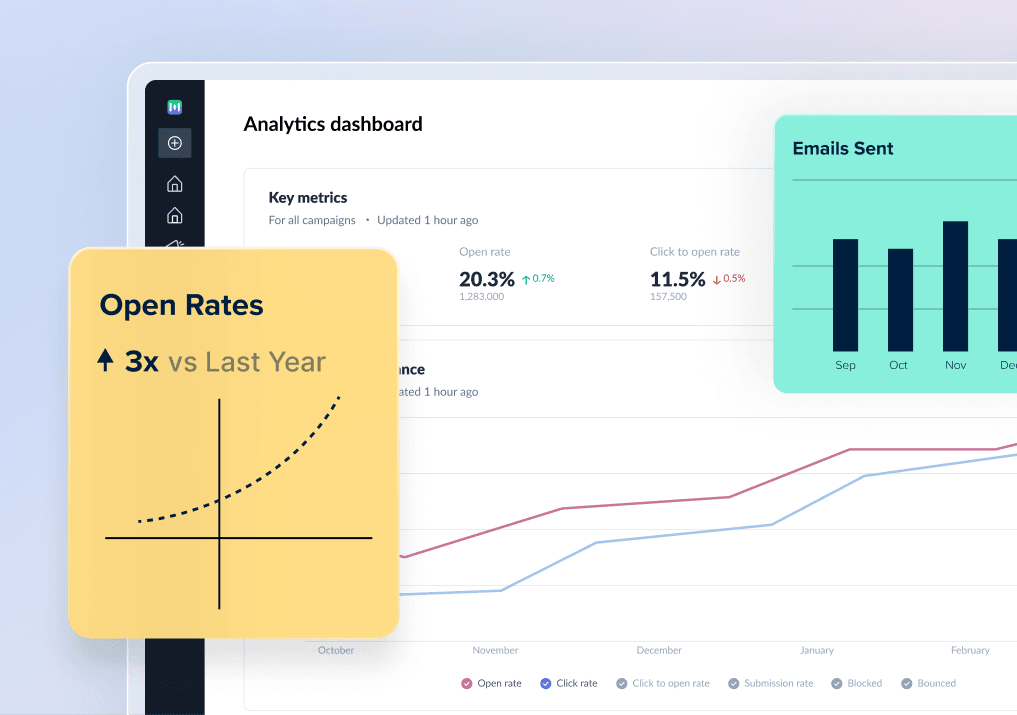Email marketing remains one of the most effective ways retailers engage with customers and drive sales. Studies have shown that email marketing has a higher return on investment than other marketing channels. In fact, the ROI of email also increased 8% in a year from $47.75 to $51.52 for every $1.35 spent.
However, a successful retail email marketing campaign requires creativity and strategy, and creating one for yourself can be overwhelming. This guide contains a curated list of retail email marketing examples guaranteed to boost your sales and increase customer engagement. You can use these strategies to improve your email marketing efforts, whether you're a small boutique or a large e-commerce store.
Table of contents
10 Retail email marketing strategies to follow
- 1. Segment your email list
- 2. Craft compelling subject lines to grab the attention
- 3. Personalize your emails
- 4. Use email automation
- 5. Use customer testimonials and reviews
- 6. Use offers and discounts
- 7. Monitor the performance of your email campaigns
- 8. Optimize for all devices
- 9. Test your emails
- 10. Use interactive/AMP-powered emails
What is retail email marketing?
Retail email marketing is a digital strategy leveraging email communication to promote products, engage customers, and boost sales for retail businesses. It includes campaigns like promotional emails, transactional emails, newsletters, abandoned cart emails, loyalty emails, and product recommendations. This approach helps build a direct and personalized connection, fostering brand awareness and customer loyalty and driving sales.
Why should retailers use email marketing?
Email marketing is a powerful tool to help retailers improve sales, gain valuable feedback, retain customers, provide information about new products, send order confirmations and receipts, and encourage repeat purchases.
By leveraging email marketing, retailers can connect with customers on a deeper level and create personalized experiences. Here's how email marketing can help retailers.
1. Improve sales: By strategically sending targeted emails to the right audience at the right time, and retailers can drive traffic to their online store or physical location and generate more sales.
2. Collect feedback: By including surveys or feedback forms in their emails, retailers can gain insights into customer preferences, buying behavior, and overall customer satisfaction.
3. Retain customers: By nurturing existing relationships through regular communication, retailers can build customer trust and loyalty. This can be achieved by sending personalized emails with relevant content and tailored recommendations based on customers' past purchases or interests.
4. Promote products and services: By sending product updates and announcements, retailers can generate excitement and anticipation among their audience. This can lead to increased interest in the products and more sales.
5. Enhance customer experience: By including helpful information, such as order tracking details or suggestions for related products, retailers can create a seamless and personalized shopping experience for their customers.
What kind of emails can you send to your customers?
In retail email marketing, sending the right emails at the right time is paramount. You can send different types of emails, and each type serves a specific purpose.
Welcome emails
When crafting your welcome emails, it's important to express gratitude for their decision to join your email list or make a purchase. Showcasing your brand personality and values can help make a personal connection with your audience. Additionally, using this opportunity to provide information about your company, including your mission, values, and unique selling points, can help reinforce your brand image.
Product announcements
Creating a sense of exclusivity and urgency is important when crafting product announcement emails. Give your audience a sneak peek or a hint of what's to come. This creates anticipation and curiosity, making your customers eager to learn more.
To create a sense of urgency, offer limited-time promotions or discounts exclusively for your email subscribers. This creates a fear of missing out (FOMO), which helps drive immediate sales.
Offers and promotions
Generate excitement for new products and enhance retail email marketing by regularly providing special promotions and discounts to subscribers. This not only incentivizes purchases but also fosters customer loyalty and repeat business. When planning offers, tailor them to your target audience's preferences; for instance, a clothing retailer could offer exclusive discounts on seasonal items or a "buy one, get one free" promotion for specific product categories.
Post-purchase emails
Extend customer engagement beyond the initial purchase. Send a thank-you email to express gratitude and gather feedback, inviting reviews or suggestions. This not only shows appreciation but also provides valuable insights for improvement. Utilize cross-selling or upselling strategies by recommending complementary products or upgrades, leveraging customer purchase history or browsing behavior. This boosts the average order value and introduces customers to a broader product range, fostering brand loyalty and encouraging repeat purchases.
Cart abandonment
When sending emails, it's important to remind customers about the items they left behind and create a sense of urgency. In your cart abandonement emails, offer incentives such as limited-time discounts or free shipping to incentivize them to take action. Including customer reviews or testimonials can also provide social proof and reinforce the value of the products they are interested in.
Event promotion
Event promotion is another effective strategy in retail email marketing that can significantly boost sales. Whether you're hosting a grand opening, a product launch, or a special sale event, sending targeted emails to your customers can create excitement and anticipation.
When promoting an event through email, it's crucial to highlight the unique aspects and benefits to your customers. Communicate the event's date, time, and location clearly, along with any special offers or discounts. Use compelling images and concise copy to capture the audience's attention and encourage them to RSVP or visit your store.
Seasonal campaigns
Seasonal campaigns are an essential component of successful retail email marketing strategies. You can create a sense of urgency and drive sales by tapping into the holiday spirit or aligning your promotions with seasonal events. Whether it's Valentine's Day, Black Friday, or even the start of a new season, incorporating seasonal elements into your email campaigns can capture your customers' attention and encourage them to purchase.
Anniversary/birthday emails
Birthdays and special occasions present a valuable opportunity for retailers to connect with their customers personally. By acknowledging and celebrating these milestones, you foster a sense of loyalty and strengthen your relationship with your audience.
10 Retail email marketing strategies to follow
Now you know how important it is to have a retail email marketing strategy. Let's have a look at 10 proven strategies:
1. Segment your email list
Segmented email campaigns are highly effective in boosting sales and increasing customer engagement for retail businesses. By dividing your email list into specific target groups based on demographics, interests, and purchasing behavior, you can tailor your messages to resonate better with each segment.
2. Craft compelling subject lines to grab the attention
Your subject line is the first thing your customers see in their inbox, so it needs to grab their attention and entice them to open the email. Remember to keep your subject lines concise and clear, avoiding misleading or spammy tactics.
If you need more inspiration or creativity, you can always use an AI subject line generator to create catchy subject lines for your emails. Mailmodo's AI subject line generator is a great example.
3. Personalize your emails
Personalization is the key to creating content to boost your sales through email marketing. Start by segmenting your email list based on various factors such as demographics, purchase history, or browsing behavior. This will allow you to tailor your content to specific customer groups, making it more relevant and valuable to them.
4. Use email automation
To automate email marketing campaigns effectively, opt for a trustworthy Email Service Provider (ESP) like Mailmodo. ESPs provide automation features such as triggered emails, drip campaigns, and email funnels, enabling you to nurture leads and convert them into customers. Personalized workflows can be set up to automatically send targeted emails based on customer actions, such as creating an abandoned cart campaign to remind customers to complete their purchases.
5. Use customer testimonials and reviews
Building trust with your customers is crucial, and an effective way to do this is by incorporating customer testimonials and reviews into your email campaigns. Including positive feedback from satisfied customers adds credibility to your brand and helps potential customers make informed purchasing decisions.
Consider featuring customer testimonials prominently in your email templates. You can showcase quotes or short snippets of reviews that highlight your customers' positive experiences. You can also include star ratings or review summaries to give a quick snapshot of what others say about your products or services.
6. Use offers and discounts
Everyone loves a good deal, so communicate the value proposition of your products or services by offering exclusive discounts, limited-time promotions, or special offers to your email subscribers.
To maximize the impact of these offers, create a sense of urgency by setting expiration dates or limited quantities. This will create a fear of missing out, encouraging your subscribers to act quickly and make a purchase.
7. Monitor the performance of your email campaigns
Regularly review the performance of your email campaigns to identify trends, patterns, and potential issues. This will help you identify areas where you can improve, such as subject lines, email design, call-to-action buttons, and targeting strategies.
8. Optimize for all devices
A responsive email design is key to providing a seamless experience for your subscribers, regardless of their device. It allows your emails to automatically adapt to the screen size, ensuring that the content is easily readable and the call-to-action buttons are clickable.
To optimize your emails for all devices, consider the following best practices:
Use a single-column layout: This ensures that your email content remains easily read and navigated on smaller screens.
Use a mobile-friendly font size: Aim for a font size of at least 14 pixels to ensure readability on smaller screens.
Simplify your design: Avoid cluttered layouts and excessive graphics that can hinder loading speeds or create a poor user experience on mobile devices.
Use large, clickable buttons: Make it easy for recipients to take action by using buttons instead of text links. Ensure the buttons are large enough to be easily clicked on touch screens.
9. Test your emails
Testing your emails ensures that your subscribers will have a seamless experience regardless of how they access them.
Start by utilizing email testing tools to preview your emails on various devices and email clients. This will give you a visual representation of how your emails will look to your subscribers.
When testing, pay attention to the following aspects:
Layout and formatting: Ensure your email content is properly aligned and formatted on different screen sizes. Check that images, text, and buttons are displayed correctly.
Font size and readability: Double-check that your font size is easily readable on various devices. Adjust if necessary to improve readability.
Button functionality: Test the functionality of your clickable buttons to ensure they work as intended on different touch screens.
Loading speed: Confirm that your email loads quickly on different devices and that any images or graphics used do not slow the loading time.
By thoroughly testing your emails, you can identify any issues or inconsistencies that could affect the user experience and fix them on time.
10. Use interactive/AMP-powered emails
Interactive emails allow you to include image carousels, video playback, product galleries, and even interactive surveys or quizzes into your emails. These interactive elements capture your subscribers' attention and provide an immersive experience that can significantly boost engagement and conversions.
Mailmodo is a platform that creates AMP-powered emails. With its drag-and-drop editor and pre-designed templates, you can easily create stunning interactive emails without any coding knowledge.
Get a sample AMP email in your inbox
Experience the power of interactivity right now
8 Retail email marketing examples for inspiration
These examples will showcase different strategies and tactics that successful retail brands have used to boost their sales through email marketing.
1. Warby Parker
Why this works: The welcome email strategy engages customers through a thank-you message, incentive promises, and an introduction to the business. Warby Parker's example utilizes white space, professional photographs, and an interactive call to action, enhancing brand consistency.
2. The Washington Post
Why this works: The promotional email effectively uses Earth Day to re-engage readers with a special deal, employing clear CTAs and highlighting benefits. The concise and focused message helps drive readers to renew their subscriptions.
3. Dote
Why this works: The cart abandonment email features a non-pushy, witty message summarizing the items left in the cart with a clear CTA to encourage customers to complete their purchase. It effectively utilizes humor and simplicity to re-engage potential buyers.
4. Headspace
Why this works: The transactional email maintains consistency with the brand's voice and visuals, providing clear information and an easy-to-find CTA. The email design uses white space effectively and includes contact information for enhanced accessibility.
5. Stocksy
Why this works: The re-engagement email reminds customers of an incomplete application, offering clear steps and a prominent CTA button. The email's tone is consistent with the brand, using striking graphics and good copy to encourage customers to return.
6. Judy
Why this works: The lead nurturing email recognizes the customer's previous interest, congratulating them and providing a clear CTA to revisit the product. The email maintains brand consistency with a professional product photo and a marked CTA button.
7. Allbirds
Why this works: The e-receipt email includes a message on the brand's commitment to the environment, reinforcing brand values. It presents a thorough receipt in an aesthetically pleasing package, subtly connecting with customers and offering opportunities for further engagement.
8. Death Wish Coffee
Why this works: The check-in email invites honest feedback, ensuring customer satisfaction and improvement. It employs a friendly tone, assures minimal time commitment for a survey, and closes with a clear CTA, reflecting the brand's commitment to quality.
Effective email marketing is indispensable in today's digital retail landscape, as demonstrated by these diverse and successful examples.
Conclusion
These retail email marketing strategies provide a framework for success in boosting your sales. You can effectively engage with your customers and increase conversions by personalizing product recommendations, offering exclusive discounts, and sending abandoned cart reminders. Acknowledging special occasions and encouraging customer feedback and reviews also play a crucial role in building customer loyalty and generating user-generated content for future campaigns.
Additionally, consider using an email service provider that can help you create and send these email campaigns. You can try Mailmodo, which provides features like a no-code email builder, email automation, A/B testing, an AI subject line generator, and a template library.






